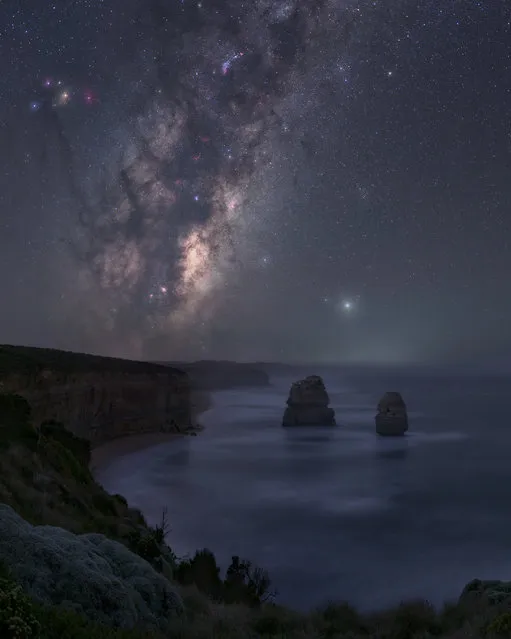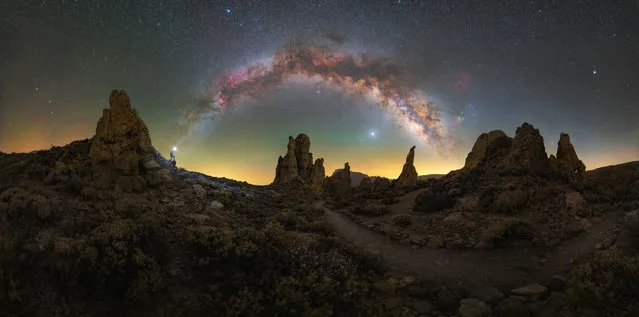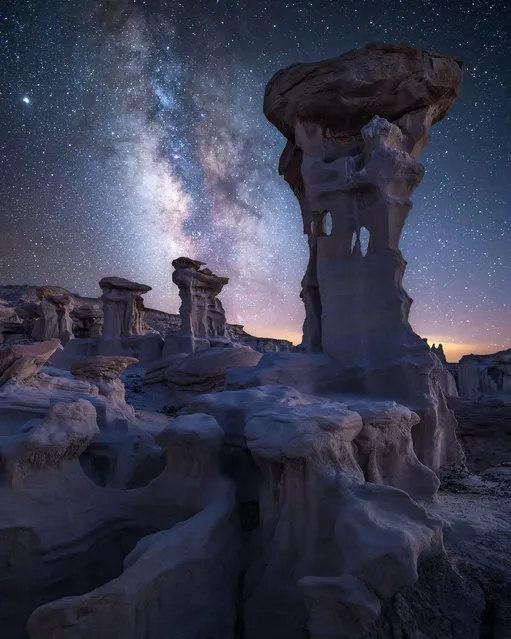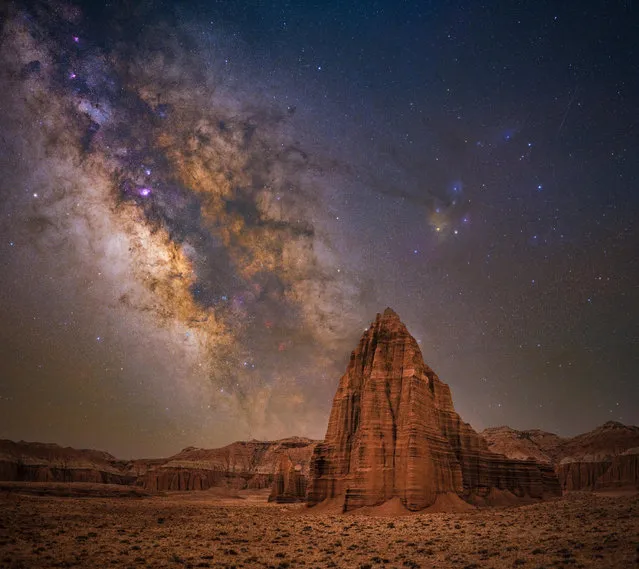
Volcano and cross; Villarrica Volcano, Chile. “If you’ve never seen the Southern Sky, it’s significantly different and truly amazing. In the northern hemisphere, we use Polaris as the polar star, but below the equator, there are other rules. To easily recognise the south celestial pole, the best indicator is the Southern Cross constellation, located in the image just above the Villarrica volcano. This cross points to the south celestial pole and it’s easy to identify, considering the brightness of the stars. Within the cross, we can see the dark area called “the Coalsack”, which is also visible to the naked eye. It’s one of the best-known dark nebulae in the sky. In the upper left corner, there’s another night sky gem: the red-coloured Carina Nebula. This is also only visible in the southern hemisphere and, even though it’s visible to the naked eye, with a pair of binoculars, we can see all the beautiful details”. (Photo by Tomas Slovinsky/Milky Way Photographer of the Year)

Devil’s throat; Iguazu Falls, Brazil. “Photographing Iguazu Falls at night has always been one of my priority projects. I needed to obtain a special authorisation. The first challenge was to walk around the park at night knowing that several jaguars live there, which are frequently seen by employees and tourists. In the area closest to the main waterfalls, the big challenge was to make long exposure images with the strong water spray from the more than 1.5m litres per second that fall through the waterfalls. Working with exposure times longer than 10 or 15 seconds became an almost impossible task and the lens was never dry. In this image, we have one of the main waterfalls of the Iguazu Falls complex, the Santa Maria Jump. Right over the fall, we can see Saturn and the zodiacal light illuminating the horizon. Further up there is the Milky Way core. We can also identify some of the main emission nebulae present in this region of the sky”. (Photo by Victor Lima/Milky Way Photographer of the Year)

Riaño; Spain. “I captured this image last winter in the Riaño mountain reservoir in Spain. The biggest difficulty that night was mainly the cold; it was over -10 degrees. The moisture in the reservoir was freezing the lens and it was difficult to shoot for a long period of time. I planned the photograph using PhotoPills and, when the weather forecast was promising, I decided to try for it. The composition of the winter Milky Way over the mountains and the reservoir created magical scenery”. (Photo by Pablo Ruiz/Milky Way Photographer of the Year)

Paradise; Big Sur, California. “If I had to choose my favourite place on Earth, this might be it. Located on the Pacific coast near Big Sur, it really has everything: a beautiful cove filled with emerald waters, an 80ft waterfall that falls directly on to the beach, a palm tree that makes you feel like you’re on a tropical island, and a perfectly dark sky that shines bright with stars at night”. (Photo by Marcin Zajac/Milky Way Photographer of the Year)

Chamber of light; Utah, US. “The deserts of the south-west abound with places to capture the night sky. With all that the south-west has to offer, it’s easy to overlook some of the more obscure hidden gems hovering under the radar. This is one such location, which is situated below a remote set of cliffs in Grand Staircase-Escalante. Due to its remoteness, this natural stone chamber provides some of the clearest, most pristine views of the Milky Way framed by the copper-coloured opening of the cavern”. (Photo by Spencer Welling/Milky Way Photographer of the Year)

Night lovers; Hormozgan province, Iran. “In this picture, you can see the Milky Way rising on a fascinating spring night on the Persian Gulf coast. The stunning cliffs of this area make every viewer imagine and even talk to them! The light pollution from a faraway city was quite strong, so it was a challenging post-processing process. I’m a nightscaper who tries to achieve an artistic look in my images, and in this image, I tried to convey and capture the magic of this location”. (Photo by Mohammad Hayati/Milky Way Photographer of the Year)

Nyctophilia; Great Ocean Road, Victoria, Australia. “This incredible location has always amazed me, even before I had any interest in photography. This set of rocks, carved by the incessant churning of the sea and the powerful wind that whips the south coast of Victoria is, without a doubt, the most emblematic landscape of Australia. After an amazing sunset followed by an ethereal moonset, I was standing there, contemplating the spot I had always dreamt of under a magical starry sky. However, not everything was pink that night … I had brought a new piece of equipment with me, a star tracker, and as soon I started to set it up, I knew it was going to be a tricky night. After numerous failed attempts to align it towards the south celestial pole, I was ready to give up, but I decided to take a shot and “see what happens” while the galactic core was rising up. Surprisingly, it worked out nicely, and a door opened for me, to a new magical world full of stars”. (Photo by José Luis Cantabrana/Milky Way Photographer of the Year)

Rising from the dust; Tenerife, Canary Islands, Spain. “From my adventure in Tenerife, this image is the one that best represents my experience, both the “good” and the “bad” side. As you can see in the photo, the landscape is shaped by incredible volcanic structures that rise toward the sky as huge towers that perfectly frame the mighty Milky Way. Then our home galaxy seems to rise from a thick blanket of dust that scatters all the light from the faraway towns, creating a warm glow over the horizon. This glow is caused by the “calima”, a warm wind that comes from Africa. Loaded with the sand of the desert, it has a big impact on night sky visibility, obscuring the beautiful Milky Way. In the end, all the good and bad things came together perfectly in this image, giving me the chance to show you this incredible panorama”. (Photo by Lorenzo Ranieri Tenti/Milky Way Photographer of the Year)

ADK magic; Adirondack Mountains, New York, US. “The east coast is less commonly known for Milky Way photography due to its condensed population and, as a result, intense light pollution. However, there are still a few dark skies remaining … tucked away in upstate NY, the Adirondacks region consists of 6m acres of land designated as “forever wild”. It is home to some of the last known darkest skies on the east coast. I feel like I am home when I am hiking in the Adirondacks. This shot, then, captures the magic which I feel fills my heart when I am there. Not only does it consist of a lake which seems to take the formation of a heart itself, but it also shows just how much the east coast has to offer: beautiful woodlands combined with still water and rolling hills. My heart is in these mountains, and I am so thankful to be able to explore them. With that in mind, these mountains are constantly being swarmed with light pollution. The yellow glow on the horizon is light pollution from within the region as well as way off in the distance. My goal is to attempt to use my photography to raise awareness about the issue and restore the night. Remember: if you plan to visit the region, please read up on all current regulations, and leave no trace on site”. (Photo by Daniel Stein/Milky Way Photographer of the Year)

Mount Taranaki Milky Way; Fanthams Peak, Mount Taranaki, New Zealand. “This is one of the most challenging shots I have ever captured, as it required climbing for four hours in 70km/h winds to reach the ice summit of Fanthams Peak – a volcano on the side of Mount Taranaki. At an elevation of 2000 metres and -15C outside with gusty wind blasts, I had to choose settings that would get me the capture rather than what I may have considered more ideal settings. I am so stoked to have captured what I did under perfect clear skies, as it was both a true test of both mountaineering and endurance carrying all my gear to this location, but one I will look back on with pride and success”. (Photo by Larryn Rae/Milky Way Photographer of the Year)

Navajo nights; Bisti Badlands, New Mexico, US. “The mountainous west is awash in beauty, culture, history and tradition, and sites like this, in the Bisti badlands, are treasures to behold and cherish. Arriving before sunset, I encountered several other photographers occupying the position best known as the classic shot of this place. In no way ruffled, I scouted the area, as I normally do, looking intently for compelling compositions. When I saw this scene, and verified with the PhotoPills app that the Milky Way core would perfectly align with the rock feature, I was hooked. With the silhouette of my Navajo guide nearby, I shot the foreground as blue hour washed over this ancient land, then watched with joy as the stars coursed through the heavens above. When the Milky Way rose into prominence and settled where I had hoped, I exposed for the sky to complete this blend. Always remember that while these are amazing natural wonders, these sites hold far greater significance for the Navajo people. Let us all protect and cherish these lands for generations to come. If I could leave you with just one piece of advice, it would be: always scout for your own compositions. Be a photographer, not a photocopier”. (Photo by Christine Kenyon/Milky Way Photographer of the Year)

Dragon’s lair; Mungo, NSW, Australia. “This is my favourite nightscape image to date. Mungo is a 12-hour drive away from my home in Sydney, but those Bortle 1 skies are the best I’ve ever witnessed and photographed at night. I had perfect conditions for three straight nights, with really good seeing throughout. The moment I came upon this scene, I knew exactly what I wanted to the name the image. It was otherworldly – think Game of Thrones – and it lined up perfectly for how I wanted to capture it. Large, jagged walls framed a winding path leading to a centred spire to the west. There was only ever going to be one way to do it justice and that was as a multi-layered Milky Way panorama. I planned this image using PhotoPills during the day, but in post-processing, I decided to use the blue-hour blend for the foreground with a tracked sky for the cleanest possible image”. (Photo by Daniel Thomas Gum/Milky Way Photographer of the Year)

GranTeCan; La Palma, Canary Islands, Spain. “On the last night of my trip to La Palma, I went up to the “Roque de los Muchachos”, where I enjoyed a nice dinner with my girlfriend while watching the spectacular sunset over the sea of clouds that is typical of this location. Moments later, the first stars were already visible and I set up my camera gear. The night was fantastic; there was no wind and no “calima” on the horizon. After several tests, I opted for a 50mm focal length that allowed me to capture a closer perspective of the telescope while framing our galactic bulge”. (Photo by Antonio Solano/Milky Way Photographer of the Year)

The Watchman; Zion National Park, Utah, US. “Utah’s dark skies are a mecca for astrophotographers from around the world. Zion national park is one of the premier locations and, for as long as I can remember, nightscapes from this park have captured my imagination. When I finally travelled to Zion, I knew I wanted to capture something unique, something different from the traditional shot, but one that still featured the iconic and austere “Watchman”. I had seen some photos from a closer angle and after some exploring, I came across this twisted skeleton of an old juniper framing the Watchman. As a photographer, I am always looking for interesting foreground subjects. Foregrounds that have features that can in some way recapitulate or accentuate the background are rare but always the most compelling. When I noticed how the angles of the tree matched the peak near perfectly, I knew I had found something special. This composition is a blue-hour blend with the sky taken at night and the foreground taken before the sun came above the horizon”. (Photo by Brandt Ryder/Milky Way Photographer of the Year)

Temple of the Sun; Capitol Reef national park, Utah, US. “The Milky Way core rises before dawn under the southern skies of Capitol Reef national park’s ‘Temple of the Sun’. This area of the Colorado Plateau desert, known for its domes, hoodoos, fins, reefs, natural bridges and slot canyons, includes the Temples of the Sun and Moon. These Jurassic-aged sandstone monoliths, which formed as sandy mud on a tidal flat, tower above the otherwise flat desert floor. It seems like more than a coincidence that the Temples line up perfectly with the Milky Way, their vibrant orange colours seemingly reflecting the colour of the stars above”. (Photo by Bryony Richards/Milky Way Photographer of the Year)
01 Jun 2021 09:42:00,
post received
0 comments
